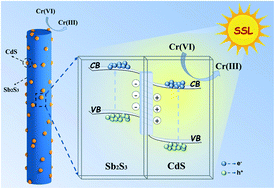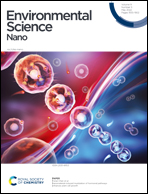Simulated-sunlight-driven Cr(vi) reduction on a type-II heterostructured Sb2S3/CdS photocatalyst†
Abstract
Photocatalysis technology is a promising strategy to solve Cr(VI) pollution in wastewater. Transition metal sulfides (TMSs) are identified as a kind of important photocatalytic material, but they are easy to be photocorroded under light-irradiation, resulting in unstable photoactivity. Among TMSs, large-sized antimony trisulfide (Sb2S3) possesses prominent structural stability. However, long-period migration of body photocarriers generally leads to high-frequency recombination behavior followed by low quantum yield. To address this challenge, CdS nanoparticles here were uniformly anchored on the surface of Sb2S3 nanorods to construct a heterostructured catalyst via a solvothermal method. Due to the formation of a type-II heterointerface, body-to-surface photocarriers' migration was boosted significantly, resulting in obviously suppressed photocarrier recombination and high photocarrier utilization. Thereby, stable and highly improved simulated-sunlight (SSL) driven photoactivity for Cr(VI) reduction was achieved on the optimized catalyst, exceeding that on bare Sb2S3 by ∼138 times. Through regulating the pH value of Cr(VI) solution (pH = 2.0), the Cr(VI) ions can be completely converted to Cr(III) after 2 min, and excellent resistance ability to impurity ions and photostability were shown by this catalyst. This study broadens the application of Sb2S3 semiconductors in the photocatalysis field and provides a feasible strategy for fast remediation of Cr(VI) wastewater.

- This article is part of the themed collections: Environmental Remediation and Best Papers 2022 – Environmental Science: Nano


 Please wait while we load your content...
Please wait while we load your content...